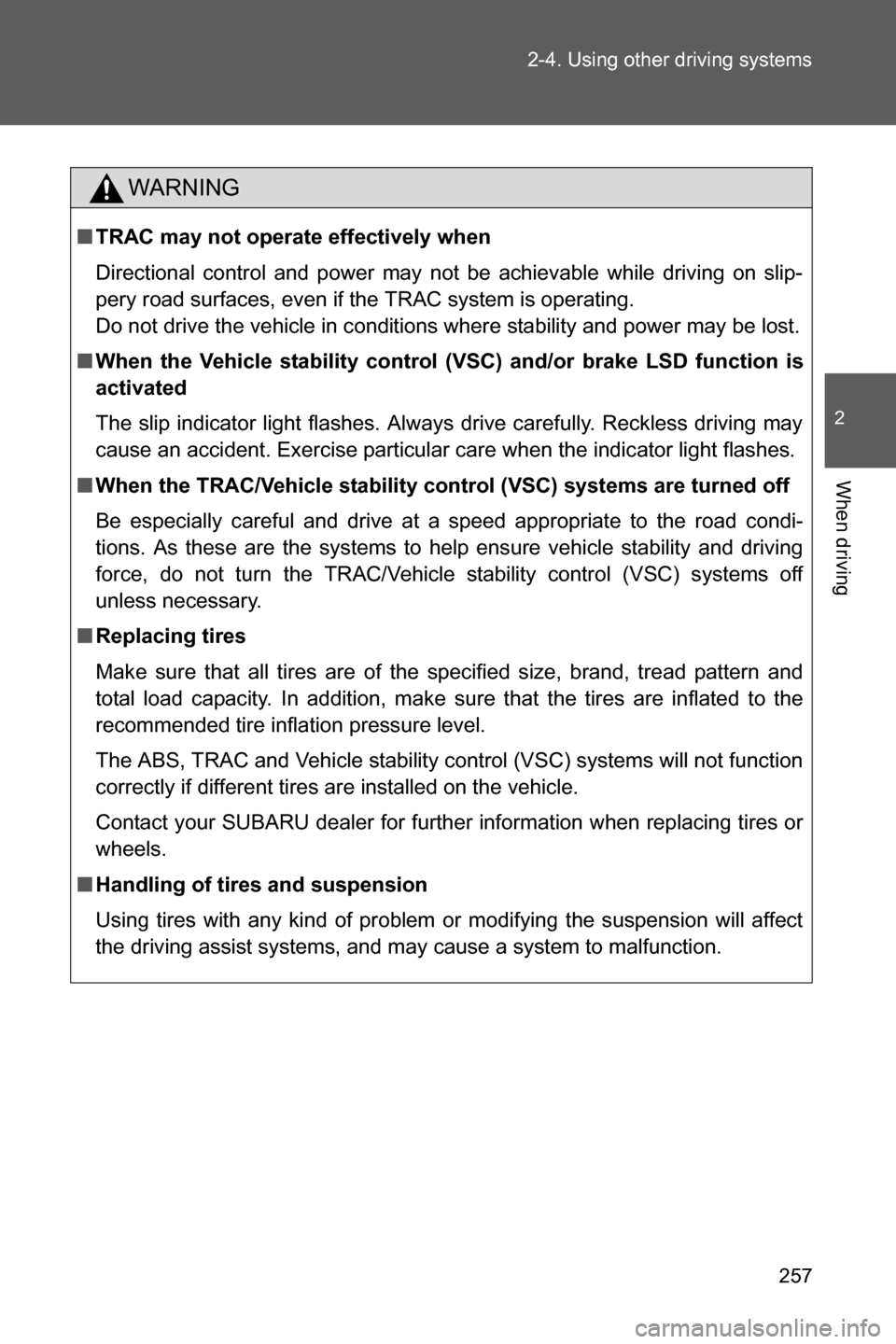Page 242 of 540
240 2-4. Using other driving systems
■Accelerating after setting the vehicle speed
●The vehicle can be accelerated normally. After acceleration, the set
speed resumes.
●Even without canceling the cruise control, the set speed can be
increased by first accelerating the vehicle to the desired speed and then
pushing the lever down to set the new speed.
■Automatic cruise control cancelation
Cruise control will stop maintaining the vehicle speed in any of the following
situations.
●Actual vehicle speed is below approximately 20 mph (30 km/h).
●Vehicle stability control (VSC) is activated.
■The system may be malfunctioning when
In the following situations, the system may be malfunctioning. Have the vehi-
cle inspected by your SUBARU dealer.
●The cruise control indicator light comes on in yellow.
●The cruise control indicator does not come on even when the “ON-OFF”
button is pressed while the engine is running.
Page 250 of 540

248 2-4. Using other driving systems
●Strong light shined on the rear view camera lens may develop white light
stripes around the light source. This is not a malfunction.
●Under fluorescent lighting, the display may flicker. However, this is not a
malfunction.
●It may be difficult to see the image from the rear view camera in the fol-
lowing situations. This is not a malfunction.
●When the vehicle is in a dark area (at night, in a tunnel, etc.).
●When the vehicle is in an extremely hot or cold place.
●When foreign matter (such as raindrops, snow, dirt, etc.) that disturbs the
view of the rear view camera is stuck to the lens of the rear view camera.
●When strong lights shine directly into the camera lens (in this case, verti-
cal lines may be displayed on the screen).
■Taking care of the rear view camera
●Do not clean the rear view camera with alcohol, benzine or paint thinner.
Otherwise, discoloration may occur. To remove contamination, wipe the
rear view camera with a cloth moistened with a diluted neutral detergent
and then wipe it with a soft, dry cloth.
●When waxing the vehicle, be careful not to apply wax to the rear view
camera. If wax contacts the rear view camera, remove it with a clean
cloth moistened with a diluted neutral detergent.
●The camera lens has hard coating to help prevent scratches. However,
when washing the vehicle or cleaning the camera lens, be careful not to
scratch the camera lens. Do not use a washing brush directly on the
camera lens as the displayed image may be adversely affected.
Page 254 of 540
252 2-4. Using other driving systems
When the TRAC/Vehicle stability control (VSC) systems are operating
The slip indicator light will flash
while the TRAC (brake LSD
function)/Vehicle stability control
(VSC) systems are operating.
Disabling the TRAC system
If the vehicle gets stuck in mud, dirt or snow, the TRAC system may
reduce power from the engine to the wheels. Pressing to turn
the system off may make it easier for you to rock the vehicle in order
to free it.
In this case, the brake LSD function remains on.
To turn the TRAC system off,
quickly press and release the
button.
The Traction Control System OFF
indicator light will come on.
Press the button again to turn the
system back on.
Page 256 of 540
254 2-4. Using other driving systems
Selecting TRAC mode and Vehicle stability control (VSC) mode
Modes can be selected to suit your driving conditions as follows:
*1:Vehicles with an automatic transmission
*2:Vehicles with a manual transmission
Driving
conditionsTRAC
modesVehicle sta-
bility control
(VSC) modesBrake LSD
functionIndicator lights
Normal
roadsNormal
modeNormal
modeNormal
mode�
Rough
roadsOffNormal
modeNormal
mode
Sport
driving“TRACK”
mode“TRACK”
mode“TRACK”
mode
Off Off“TRACK”
mode
*1
Off*2
Page 257 of 540

255 2-4. Using other driving systems
2
When driving
■Turning off both TRAC and Vehicle stability control (VSC) systems
To turn the TRAC and Vehicle stability control (VSC) systems off, press and
hold for more than 3 seconds while the vehicle is stopped.
The Traction Control System OFF indicator light and the Vehicle stability
control (VSC) off indicator light will come on.
However, on vehicles with an automatic transmission, the brake LSD func-
tion will remain on.
Press the button again to turn the systems back on.
■Automatic reactivation of TRAC and Vehicle stability control (VSC) sys-
tems
After turning the TRAC and Vehicle stability control (VSC) systems off, the
systems will be automatically reactivated in the following situations:
●Vehicles without a keyless access with push button start system: When
the engine switch is turned to “LOCK” position
●Vehicles with a keyless access with push button start system: When the
push-button ignition switch is turned off
●If only the TRAC system is turned off, the TRAC will turn on when vehicle
speed is more than approximately 31 mph (50 km/h).
If both the TRAC and Vehicle stability control (VSC) systems are turned
off, automatic reactivation will not occur when vehicle speed increases.
■Automatic deactivation of “TRACK” mode
Vehicles without a keyless access with push button start system
When the engine switch is turned to “LOCK” position after driving in
“TRACK” mode, the mode is automatically deactivated.
Vehicles with a keyless access with push button start system
When the push-button ignition switch is turned off after driving in “TRACK”
mode, the mode is automatically deactivated.
■Sounds and vibrations caused by the ABS, brake assist, TRAC and
Vehicle stability control (VSC) systems
●A sound may be heard from the engine compartment when the brake
pedal is depressed repeatedly, when the engine is started or just after the
vehicle begins to move. This sound does not indicate that a malfunction
has occurred in any of these systems.
Page 258 of 540

256 2-4. Using other driving systems
●Any of the following conditions may occur when the above systems are
operating. None of these indicates that a malfunction has occurred.
• Vibrations may be felt through the vehicle body and steering.
• A motor sound may be heard after the vehicle comes to a stop.
• The brake pedal may pulsate slightly after the ABS is activated.
• The brake pedal may move down slightly after the ABS is activated.
■Electric power steering operation sound
When the steering wheel is operated, a motor sound (whirring sound) may
be heard. This does not indicate a malfunction.
■Reduced effectiveness of the electric power steering system
The effectiveness of the electric power steering system is reduced to pre-
vent the system from overheating when there is frequent steering input over
an extended period of time. The steering wheel may feel heavy as a result.
Should this occur, refrain from excessive steering input or stop the vehicle
and turn the engine off. The electric power steering system should return to
normal after a little while.
WARNING
■The ABS does not operate effectively when
●Tires with inadequate gripping ability are used (such as excessively worn
tires on a snow covered road).
●The vehicle hydroplanes while driving at high speed on wet or slick roads.
■Stopping distance when the ABS is operating may exceed that of nor-
mal conditions
The ABS is not designed to shorten the vehicle’s stopping distance. Always
maintain a safe distance from the vehicle in front of you in the following situ-
ations:
●When driving on dirt, gravel or snow-covered roads
●When driving with tire chains
●When driving over bumps in the road
●When driving over roads with potholes or uneven surfaces
Page 259 of 540

257 2-4. Using other driving systems
2
When driving
WARNING
■TRAC may not operate effectively when
Directional control and power may not be achievable while driving on slip-
pery road surfaces, even if the TRAC system is operating.
Do not drive the vehicle in conditions where stability and power may be lost.
■When the Vehicle stability control (VSC) and/or brake LSD function is
activated
The slip indicator light flashes. Always drive carefully. Reckless driving may
cause an accident. Exercise particular care when the indicator light flashes.
■When the TRAC/Vehicle stability control (VSC) systems are turned off
Be especially careful and drive at a speed appropriate to the road condi-
tions. As these are the systems to help ensure vehicle stability and driving
force, do not turn the TRAC/Vehicle stability control (VSC) systems off
unless necessary.
■Replacing tires
Make sure that all tires are of the specified size, brand, tread pattern and
total load capacity. In addition, make sure that the tires are inflated to the
recommended tire inflation pressure level.
The ABS, TRAC and Vehicle stability control (VSC) systems will not function
correctly if different tires are installed on the vehicle.
Contact your SUBARU dealer for further information when replacing tires or
wheels.
■Handling of tires and suspension
Using tires with any kind of problem or modifying the suspension will affect
the driving assist systems, and may cause a system to malfunction.
Page 260 of 540

258
2-4. Using other driving systems
Hill star t assist
The hill start assist system helps to maintain braking force to assist
starting off forward while facing uphill or starting off backward while
facing downhill. As the hill start assist system is initially disabled,
enable the system to make it operable. The enabled/disabled setting
will be maintained the next time the engine is started.
When the system is enabled,
the hill start assist ON indica-
tor will be illuminated.
■Enabling the hill start assist system
Park your vehicle in a flat, safe location.
Make sure that the parking brake is securely engaged.
Stop the engine by turning the engine switch to the “LOCK”
position (vehicles without a keyless access with push but-
ton start system) or turning the push-button ignition switch
off (vehicles with a keyless access with push button start
system).
Start the engine and check that the ABS warning light and
slip indicator are off.
Press and hold for
approximately 30 seconds.
Check that both the Vehicle
stability control (VSC) off indi-
cator and Traction Control Sys-
tem OFF indicator illuminate
and then turn off.
STEP 1
STEP 2
STEP 3
STEP 4